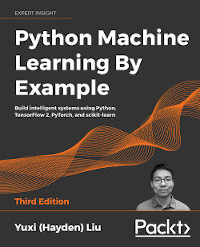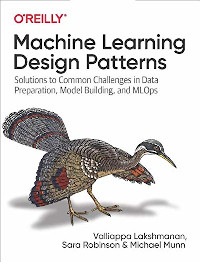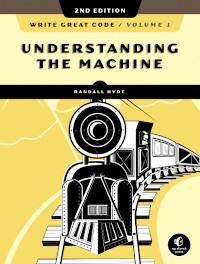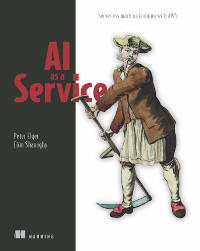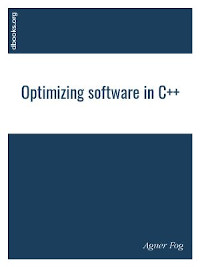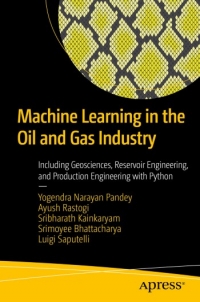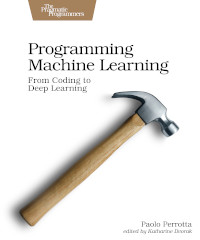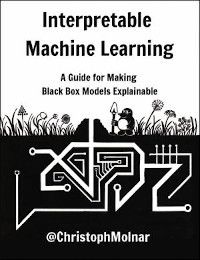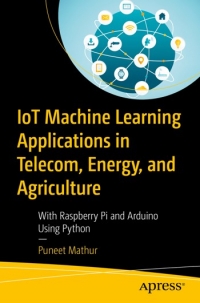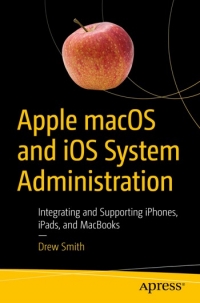Mac eBooks
Python Machine Learning By Example, 3rd Edition
Python Machine Learning By Example, 3rd Edition serves as a comprehensive gateway into the world of machine learning (ML). With six new chapters, on topics including movie recommendation engine development with Naïve Bayes, recognizing faces with support vector machine, predicting stock prices with artificial neural networks, categorizing images of clothing with convolutional neural networks, predicting with sequences using recurring neural networks, and leveraging reinforcement learning for making decisions, the book has been considerably updated for the latest enterprise requirements. At the same time, this book provides actionable insights on the key fundamentals of ML with Python programming. Hayden applies his expertise to demonstrate implementations of algorithms in Python, both from scratch and with libraries. Each chapter walks through an industry-adopted application. With the help of realistic examples, you will gain an understanding of the mechanics of ML techniques ...
Python Machine Learning By Example, 3rd Edition serves as a comprehensive gateway into the world of machine learning (ML). With six new chapters, on topics including movie recommendation engine development with Naïve Bayes, recognizing faces with support vector machine, predicting stock prices with artificial neural networks, categorizing images of clothing with convolutional neural networks, predicting with sequences using recurring neural networks, and leveraging reinforcement learning for making decisions, the book has been considerably updated for the latest enterprise requirements. At the same time, this book provides actionable insights on the key fundamentals of ML with Python programming. Hayden applies his expertise to demonstrate implementations of algorithms in Python, both from scratch and with libraries. Each chapter walks through an industry-adopted application. With the help of realistic examples, you will gain an understanding of the mechanics of ML techniques ...
Machine Learning Design Patterns
The design patterns in this book capture best practices and solutions to recurring problems in machine learning. The authors, three Google engineers, catalog proven methods to help data scientists tackle common problems throughout the ML process. These design patterns codify the experience of hundreds of experts into straightforward, approachable advice. In this book, you will find detailed explanations of 30 patterns for data and problem representation, operationalization, repeatability, reproducibility, flexibility, explainability, and fairness. Each pattern includes a description of the problem, a variety of potential solutions, and recommendations for choosing the best technique for your situation. You'll learn how to: Identify and mitigate common challenges when training, evaluating, and deploying ML models; Represent data for different ML model types, including embeddings, feature crosses, and more; Choose the right model type for specific problems; Build a robust training ...
The design patterns in this book capture best practices and solutions to recurring problems in machine learning. The authors, three Google engineers, catalog proven methods to help data scientists tackle common problems throughout the ML process. These design patterns codify the experience of hundreds of experts into straightforward, approachable advice. In this book, you will find detailed explanations of 30 patterns for data and problem representation, operationalization, repeatability, reproducibility, flexibility, explainability, and fairness. Each pattern includes a description of the problem, a variety of potential solutions, and recommendations for choosing the best technique for your situation. You'll learn how to: Identify and mitigate common challenges when training, evaluating, and deploying ML models; Represent data for different ML model types, including embeddings, feature crosses, and more; Choose the right model type for specific problems; Build a robust training ...
Write Great Code: Volume 1, 2nd Edition
This, the first volume in Randall Hyde's Write Great Code series, dives into machine organization without the extra overhead of learning assembly language programming. Written for high-level language programmers, Understanding the Machine fills in the low-level details of machine organization that are often left out of computer science and engineering courses. Learn: How the machine represents numbers, strings, and high-level data structures, so you'll know the inherent cost of using them; How to organize your data, so the machine can access it efficiently; How the CPU operates, so you can write code that works the way the machine does; How I/O devices operate, so you can maximize your application's performance when accessing those devices; How to best use the memory hierarchy to produce the fastest possible programs. Great code is efficient code. But before you can write truly efficient code, you must understand how computer systems execute programs and how abstractions in prog ...
This, the first volume in Randall Hyde's Write Great Code series, dives into machine organization without the extra overhead of learning assembly language programming. Written for high-level language programmers, Understanding the Machine fills in the low-level details of machine organization that are often left out of computer science and engineering courses. Learn: How the machine represents numbers, strings, and high-level data structures, so you'll know the inherent cost of using them; How to organize your data, so the machine can access it efficiently; How the CPU operates, so you can write code that works the way the machine does; How I/O devices operate, so you can maximize your application's performance when accessing those devices; How to best use the memory hierarchy to produce the fastest possible programs. Great code is efficient code. But before you can write truly efficient code, you must understand how computer systems execute programs and how abstractions in prog ...
AI as a Service
Companies everywhere are moving everyday business processes over to the cloud, and AI is increasingly being given the reins in these tasks. As this massive digital transformation continues, the combination of serverless computing and AI promises to become the de facto standard for business-to-consumer platform development - and developers who can design, develop, implement, and maintain these systems will be in high demand! AI as a Service is a practical handbook to building and implementing serverless AI applications, without bogging you down with a lot of theory. Instead, you'll find easy-to-digest instruction and two complete hands-on serverless AI builds in this must-have guide! Cloud-based AI services can automate a variety of labor intensive business tasks in areas such as customer service, data analysis, and financial reporting. The secret is taking advantage of pre-built tools like Amazon Rekognition for image analysis or AWS Comprehend for natural language processing. That ...
Companies everywhere are moving everyday business processes over to the cloud, and AI is increasingly being given the reins in these tasks. As this massive digital transformation continues, the combination of serverless computing and AI promises to become the de facto standard for business-to-consumer platform development - and developers who can design, develop, implement, and maintain these systems will be in high demand! AI as a Service is a practical handbook to building and implementing serverless AI applications, without bogging you down with a lot of theory. Instead, you'll find easy-to-digest instruction and two complete hands-on serverless AI builds in this must-have guide! Cloud-based AI services can automate a variety of labor intensive business tasks in areas such as customer service, data analysis, and financial reporting. The secret is taking advantage of pre-built tools like Amazon Rekognition for image analysis or AWS Comprehend for natural language processing. That ...
Optimizing software in C++
This is an optimization manual for advanced C++ programmers. This book are not for beginners. Topics include: - The choice of platform and operating system. - Choice of compiler and framework. - Finding performance bottlenecks. - The efficiency of different C++ constructs. - Multi-core systems. - Parallelization with vector operations. - CPU dispatching. Efficient container class templates. ...
This is an optimization manual for advanced C++ programmers. This book are not for beginners. Topics include: - The choice of platform and operating system. - Choice of compiler and framework. - Finding performance bottlenecks. - The efficiency of different C++ constructs. - Multi-core systems. - Parallelization with vector operations. - CPU dispatching. Efficient container class templates. ...
Machine Learning in the Oil and Gas Industry
Apply machine and deep learning to solve some of the challenges in the oil and gas industry. The book begins with a brief discussion of the oil and gas exploration and production life cycle in the context of data flow through the different stages of industry operations. This leads to a survey of some interesting problems, which are good candidates for applying machine and deep learning approaches. The initial chapters provide a primer on the Python programming language used for implementing the algorithms; this is followed by an overview of supervised and unsupervised machine learning concepts. The authors provide industry examples using open source data sets along with practical explanations of the algorithms, without diving too deep into the theoretical aspects of the algorithms employed. Machine Learning in the Oil and Gas Industry covers problems encompassing diverse industry topics, including geophysics (seismic interpretation), geological modeling, reservoir engineering, and prod ...
Apply machine and deep learning to solve some of the challenges in the oil and gas industry. The book begins with a brief discussion of the oil and gas exploration and production life cycle in the context of data flow through the different stages of industry operations. This leads to a survey of some interesting problems, which are good candidates for applying machine and deep learning approaches. The initial chapters provide a primer on the Python programming language used for implementing the algorithms; this is followed by an overview of supervised and unsupervised machine learning concepts. The authors provide industry examples using open source data sets along with practical explanations of the algorithms, without diving too deep into the theoretical aspects of the algorithms employed. Machine Learning in the Oil and Gas Industry covers problems encompassing diverse industry topics, including geophysics (seismic interpretation), geological modeling, reservoir engineering, and prod ...
Statistics with Julia
Ccurrently many of Julia's users are hard-core developers that contribute to the language's standard libraries, and to the extensive package eco-system that surrounds it. Therefore, much of the Julia material available at present is aimed at other developers rather than end users. This is where our book comes in, as it has been written with the end-user in mind. The code examples have been deliberately written in a simple format, sometimes at the expense of efficiency and generality, but with the advantage of being easily readable. Each of the code examples aims to convey a specific statistical point, while covering Julia programming concepts in parallel. In a way, the code examples are reminiscent of examples that a lecturer may use in a lecture to illustrate concepts. The content of the book is written in a manner that does not assume any prior statistical knowledge, and in fact only assumes some basic programming experience and a basic understanding of mathematical notation. ...
Ccurrently many of Julia's users are hard-core developers that contribute to the language's standard libraries, and to the extensive package eco-system that surrounds it. Therefore, much of the Julia material available at present is aimed at other developers rather than end users. This is where our book comes in, as it has been written with the end-user in mind. The code examples have been deliberately written in a simple format, sometimes at the expense of efficiency and generality, but with the advantage of being easily readable. Each of the code examples aims to convey a specific statistical point, while covering Julia programming concepts in parallel. In a way, the code examples are reminiscent of examples that a lecturer may use in a lecture to illustrate concepts. The content of the book is written in a manner that does not assume any prior statistical knowledge, and in fact only assumes some basic programming experience and a basic understanding of mathematical notation. ...
Programming Machine Learning
Peel away the obscurities of machine learning, starting from scratch and going all the way to deep learning. Machine learning can be intimidating, with its reliance on math and algorithms that most programmers don't encounter in their regular work. Take a hands-on approach, writing the Python code yourself, without any libraries to obscure what's really going on. Iterate on your design, and add layers of complexity as you go. Build an image recognition application from scratch with supervised learning. Predict the future with linear regression. Dive into gradient descent, a fundamental algorithm that drives most of machine learning. Create perceptrons to classify data. Build neural networks to tackle more complex and sophisticated data sets. Train and refine those networks with backpropagation and batching. Layer the neural networks, eliminate overfitting, and add convolution to transform your neural network into a true deep learning system. Start from the beginning and code your ...
Peel away the obscurities of machine learning, starting from scratch and going all the way to deep learning. Machine learning can be intimidating, with its reliance on math and algorithms that most programmers don't encounter in their regular work. Take a hands-on approach, writing the Python code yourself, without any libraries to obscure what's really going on. Iterate on your design, and add layers of complexity as you go. Build an image recognition application from scratch with supervised learning. Predict the future with linear regression. Dive into gradient descent, a fundamental algorithm that drives most of machine learning. Create perceptrons to classify data. Build neural networks to tackle more complex and sophisticated data sets. Train and refine those networks with backpropagation and batching. Layer the neural networks, eliminate overfitting, and add convolution to transform your neural network into a true deep learning system. Start from the beginning and code your ...
Interpretable Machine Learning
This book is about making machine learning models and their decisions interpretable. After exploring the concepts of interpretability, you will learn about simple, interpretable models such as decision trees, decision rules and linear regression. Later chapters focus on general model-agnostic methods for interpreting black box models like feature importance and accumulated local effects and explaining individual predictions with Shapley values and LIME. All interpretation methods are explained in depth and discussed critically. How do they work under the hood? What are their strengths and weaknesses? How can their outputs be interpreted? This book will enable you to select and correctly apply the interpretation method that is most suitable for your machine learning project. ...
This book is about making machine learning models and their decisions interpretable. After exploring the concepts of interpretability, you will learn about simple, interpretable models such as decision trees, decision rules and linear regression. Later chapters focus on general model-agnostic methods for interpreting black box models like feature importance and accumulated local effects and explaining individual predictions with Shapley values and LIME. All interpretation methods are explained in depth and discussed critically. How do they work under the hood? What are their strengths and weaknesses? How can their outputs be interpreted? This book will enable you to select and correctly apply the interpretation method that is most suitable for your machine learning project. ...
IoT Machine Learning Applications in Telecom, Energy, and Agriculture
Apply machine learning using the Internet of Things (IoT) in the agriculture, telecom, and energy domains with case studies. This book begins by covering how to set up the software and hardware components including the various sensors to implement the case studies in Python. The case study section starts with an examination of call drop with IoT in the telecoms industry, followed by a case study on energy audit and predictive maintenance for an industrial machine, and finally covers techniques to predict cash crop failure in agribusiness. The last section covers pitfalls to avoid while implementing machine learning and IoT in these domains. After reading this book, you will know how IoT and machine learning are used in the example domains and have practical case studies to use and extend. You will be able to create enterprise-scale applications using Raspberry Pi 3 B+ and Arduino Mega 2560 with Python. ...
Apply machine learning using the Internet of Things (IoT) in the agriculture, telecom, and energy domains with case studies. This book begins by covering how to set up the software and hardware components including the various sensors to implement the case studies in Python. The case study section starts with an examination of call drop with IoT in the telecoms industry, followed by a case study on energy audit and predictive maintenance for an industrial machine, and finally covers techniques to predict cash crop failure in agribusiness. The last section covers pitfalls to avoid while implementing machine learning and IoT in these domains. After reading this book, you will know how IoT and machine learning are used in the example domains and have practical case studies to use and extend. You will be able to create enterprise-scale applications using Raspberry Pi 3 B+ and Arduino Mega 2560 with Python. ...
Apple macOS and iOS System Administration
Effectively manage Apple devices anywhere from a handful of Macs at one location to thousands of iPhones across many locations. This book is a comprehensive guide for supporting Mac and iOS devices in organizations of all sizes. You'll learn how to control a fleet of macOS clients using tools like Profile Manager, Apple Device Enrollment Program (DEP), and Apple Remote Desktop. Then integrate your Mac clients into your existing Microsoft solutions for file sharing, print sharing, Exchange, and Active Directory authentication without having to deploy additional Mac-specific middle-ware or syncing between multiple directory services. Apple macOS and iOS System Administration shows how to automate the software installation and upgrade process using the open source Munki platform and provides a scripted out-of-the box experience for large scale deployments of macOS endpoints in any organization. Finally, you'll see how to provision and manage thousands of iOS devices in ...
Effectively manage Apple devices anywhere from a handful of Macs at one location to thousands of iPhones across many locations. This book is a comprehensive guide for supporting Mac and iOS devices in organizations of all sizes. You'll learn how to control a fleet of macOS clients using tools like Profile Manager, Apple Device Enrollment Program (DEP), and Apple Remote Desktop. Then integrate your Mac clients into your existing Microsoft solutions for file sharing, print sharing, Exchange, and Active Directory authentication without having to deploy additional Mac-specific middle-ware or syncing between multiple directory services. Apple macOS and iOS System Administration shows how to automate the software installation and upgrade process using the open source Munki platform and provides a scripted out-of-the box experience for large scale deployments of macOS endpoints in any organization. Finally, you'll see how to provision and manage thousands of iOS devices in ...
